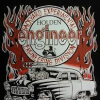I've always treated timing marks as a very rough indication only. I remember my TAFE teacher telling me I had to use a timing light and line up the marks for correct ignition timing and that was it. I argued the point saying they are not accurate due to manufacturing tolerances, movement in the harmonic balancer and rubber, timing chain stretching, worn gears, distributor advance weights, worn bushes and bearings, modified camshafts and the list goes on. My uncle was a real wizard on tuning engines and taught me how to tune engines by ear when I was 15. In many cases setting the timing by ear is more accurate than timing lights on early design engines (before late model EFI engines).
If you know what to listen for it's very easy, quicker and more accurate than any other method. With the engine at idle turn the distributor in the timing advance direction listening to the exhaust tailpipe at the same time. Generally, the engine will run a fraction smoother then a bit rougher as you continue to rotate the distributor. Then turn the distributor in the opposite direction slowly till you hear the exhaust note start to sound a bit hollow. Just advance and retard the timing a few times by rotating the distributor till you get the hang of the change in exhaust note. But what your listening for is a change to a slight hollow note (sweet spot). Lock the distributor at the point that the hollow note just starts to come in. If you keep turn the distributor further into retard (the hollow note) the engine will be too far retarded and will cause higher cylinder temperatures. No hollow note and the engine will have an advanced ignition timing and the engine may ping. Road test and check engine operation. Its rare that I need to do any further timing adjustment. However some exhaust systems can sound more hollow than other so some minor changes in timing may be needed.
Just for the record and after a lengthy Tafe class discussion our teacher decided they my method was inaccurate and would be inconsistent. I had a $15 bet with the teacher. We set five different vehicles timing by using timing lights then placing on the TAFE chassis dyno and recorded the torque and HP figures. I then set the same five vehicles timing by ear. Four out of five had increased torque and HP reading. I can't remember the readings but figures between 5 and 20 percent were achieved. The fifth car had no change.








 View Garage
View Garage








